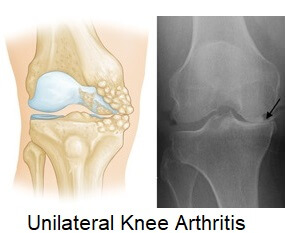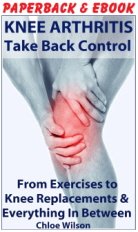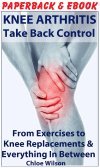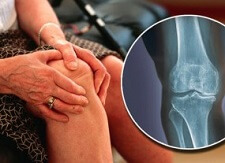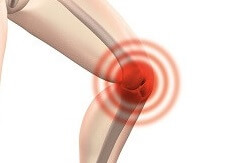- Home
- Knee Surgery
- Knee Replacements
- Partial Knee Replacements
Partial Knee Replacement
Written By: Chloe Wilson, BSc(Hons) Physiotherapy
Reviewed by: KPE Medical Review Board
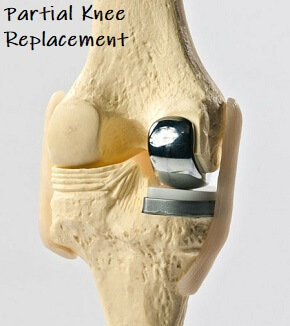
A partial knee replacement is a type of knee surgery where half of the knee joint is removed and replaced with a metal and plastic prosthesis.
Partial knee replacements are performed when there is damage to one side of the knee joint, usually from arthritis. Partial knee replacements are also known as a Uni Knee Replacement (UKR), Unicompartmental Knee Arthroplasty or PKR.
Approximately half a million partial knee replacements are carried out each year in the US. People tend to recover quickly from surgery and with the right rehab, go on to make a full recovery.
Here we will look at the indications for a UKR and how they different from total knee replacements.
We will then go on to look at what surgery involves, the rehab and recovery process and common problems associated with the a partial knee replacement.
What Is a Partial Knee Replacement?
Partial Knee Replacement surgery was developed around 30 years ago. In one third of cases, knee arthritis only affects one side of the knee. It is six times more likely to be the inner (medial) side rather than the outer (lateral) which is affected.
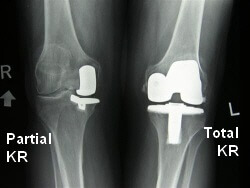
In the past, the operation of choice for knee arthritis was a total knee replacement (TKR).
This was the case whether the arthritis affected the whole knee, or just part of the knee. This meant that any healthy part of the knee joint had to be removed alongside the part affected with arthritis.
The development of partial knee replacements means that now, if arthritis is confined to only one side of the knee, that side can be replaced and the healthy bone, cartilage and ligaments do not have to undergo unnecessary surgery.
Partial knee replacement surgery itself is quicker, there is less damage to the knee, the cruciate ligaments are preserved and there are less complications than with a total knee replacement.
Who Are They Suitable For?
There are strict criteria that assess for the suitability of a partial knee replacement:
- Unilateral Arthritis: Any damaged must be confined to one side of the joint - known as unilateral arthritis. There can be no damage to the cartilage on the other side of the knee
- Severity: There must be full thickness loss of knee cartilage on the affected side. Surgery is not suitable for people with mild-moderate arthritis
- Ligaments: Both
cruciate ligaments
(ACL and PCL) should preferably be intact, however there are a few exceptions to this (see below)
- Type of Arthritis: Partial knee surgery is only suitable for osteoarthritis, not inflammatory arthritis (rheumatoid)
A person's age, weight and activity level do not usually impact suitability for the surgery.
Cruciate Ligament Damage?
As a general rule, you need all your knee ligaments to be working properly to have a Uni Knee Replacement to ensure there is enough stability for the new knee.
However in 2003, the first combined partial knee replacement and ACL reconstruction was successfully performed in Oxford in the UK. I was the physio responsible for that patient’s rehab and he made excellent progress. It is always worth discussing with your surgeon what your options are before ruling out partial knee surgery.
Should I Have A PKR?
Check Out Our Book
All the info you need about knee arthritis, top tips, exercises & loads more.
Rated 4.4/5
Find Out More
People usually do really well after a partial knee replacement. Virtually all my clients who have had one absolutely rave about them. It is obviously a bit painful for a few weeks after the surgery, but the post-operative pain is usually much less than the pain from arthritis, and even that settles within a few weeks.
People are always amazed by how quickly they are up and about and get back to all their normal activities and more after a partial knee replacement. Being able to walk, run and play sports again gives them a new lease of life.
If the surgeon thinks you are an appropriate candidate for partial knee surgery, have it. They work really well. You also have the reassurance of knowing that if something did go wrong (which hardly ever happens!) you still have the option of having a total knee replacement at a later date. It is much simpler to convert a partial knee to a total knee replacement than have a repeat TKR.
More About Knee Replacements
To find out more about partial knee replacement surgery, including what happens during surgery and the rehab and recovery process, choose from the following sections.
- Partial Knee Replacement Surgery:
What actually happens during partial knee surgery
- Recovery Process: Including success rates and returning to activities
- Problems & Risks: Common problems associated with partial knee surgery
- Common Questions: Answers to the most frequently asked questions
- Partial vs Total Knee Replacements: Compare the two to find out which surgery is right for you
- Knee Replacement Book: All the info you need on arthritis and knee replacements in a handy book
Page Last Updated: 11/10/21
Next Review Due: 11/10/23
